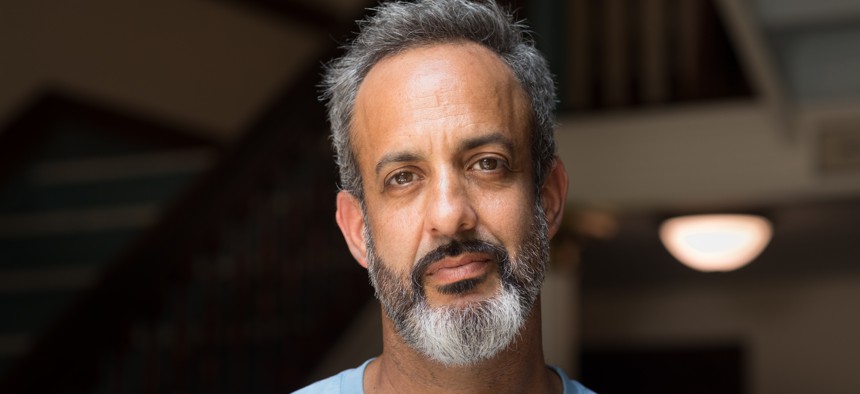Opinion
Opinion: Here's how to get the state to actually work for the frontline feeding sector
These three steps can improve how well Hunger Prevention and Nutrition Assistance Program and Nourish New York grants help feed hungry New Yorkers.

Greg Silverman is CEO of West Side Campaign Against Hunger. (Image by Amanda Gentile)
It’s no secret that food insecurity was a significant issue during the pandemic, but what people may not know is that this need has skyrocketed in the last year. Multiple times over the last month, West Side Campaign Against Hunger’s customer distribution numbers have exceeded any day on record, dwarfing the food lines seen during the pandemic. With little public sector support, frontline providers must cover the gap.
When the emergency food sector needs more funding, we seek it from a variety of sources. Of course, our network of individual and foundation donors are amazing, but city, state, and federal governments also fund our work so we can provide high-quality food to an ever-increasing customer base. Unfortunately, the money given directly to frontline emergency food providers from the state is not rising enough to keep up with the need.
Hunger Prevention and Nutrition Assistance Program and Nourish New York allocate state dollars to anti-hunger organizations to purchase food to distribute. This year the campaign, and many other frontline providers, received an 80% reduction in Nourish New York funding compared to the prior year, an astonishing drop considering just how many families are struggling to put food on the table and the growth of our distribution efforts to serve well over 80,000 New Yorkers.
State agencies have been less than forthcoming about why many emergency feeding operations, all of whom have grown their distribution efforts and innovated in countless ways to meet the need, saw significant decreases in direct funding without knowing where the money went. But my concern is not simply my organization’s revenue stream. Rather, the people most impacted by this drop, our customers, will struggle to provide proper nourishment for their families.
Looking to the next fiscal year, here are three steps for New York state to make Hunger Prevention and Nutrition Assistance Program and Nourish New York grants more effective for hungry New Yorkers:
- Develop funding metrics based on need. The lack of transparency on where state grant money was allocated and factors that informed the decision has been frustrating. New York should create an expanded budgetary framework based on food needs specific to each locality. Front line, direct service organizations know their communities best, what their needs are and how best to service them. Let’s use community generated metrics to inform grant decision making so that frontline providers can supply enough food to meet their demand.
- Reward innovation. Incentivize organizations with increased grant money to try new strategies to reach their customers. Frontline emergency feeding organizations across the state are employing novel tactics to support customers. As the ones interfacing, day in and day out, with community members on a daily basis, frontline providers are best positioned to understand their needs and implement customer-centric solutions.
One such innovation that more direct service food providers are trying is food delivery. Food pantries must move in the direction of the broader market, and as food delivery services thrive, more pantries are finding ways to bring groceries to their customers. Food pantries don’t have limitless resources to put these ideas into action, but this kind of modernization is crucial for us to reach our customers, and state grant programs could reward progress like this in their funding models.
- Give frontline providers fair access to funding. New Nourish New York grants are largely being distributed through large, regional, institutional partners, forcing frontline organizations like the campaign to receive food supply from them. For frontline organizations focused on nutritious, culturally-relevant, price-sensitive foods, this often means compromising on our mission to distribute healthy options, like fresh produce.
As a chef and a former New York restaurant owner, over-reliance on any one purveyor creates issues for providers who want to distribute the best quality options. It’s why we built The Roundtable with other frontline providers. By sharing purchase data and engaging in collective purchasing, we become less reliant on any one institutional wholesaler, get greater product choice and save money. Thanks to the roundtable’s pricing, the campaign alone is purchasing nearly 15,000 turkeys and pork shoulders for the holidays this year at a rate that is 64% lower than that offered by regional food bank institutions. Frontline organizations need direct access to state anti-hunger dollars to give community members the healthiest and best priced food possible.
The recent state grant funding decisions fly in the face of any community-focused approach to fighting hunger. It’s a shame that when New Yorkers are facing desperate times, the state has made it more difficult for frontline providers to do their essential work. We implore state administrators and legislators to hold a hearing on this issue, not only clarifying the murky funding strategy, but to use new learnings to create fairer, more equitable distribution practices and help more families in New York access healthy food.
Greg Silverman is CEO of West Side Campaign Against Hunger.
NEXT STORY: Commentary: The second miracle of East Harlem
